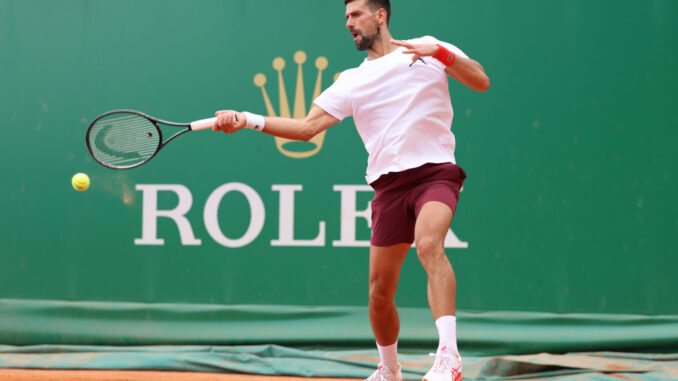
As the clay courts of Roland Garros loom on the horizon, Novak Djokovic, the 24-time Grand Slam champion, is leaving no stone unturned in his quest for a record-extending 25th major title. The 37-year-old Serbian icon, who stunned the tennis world with his late wildcard entry into the ATP 250 Geneva Open, has been spotted training intensely in Belgrade, but recent footage has sent ripples of concern through the tennis community. Strapped in a knee brace and battling to find his rhythm, Djokovic’s preparation for the May 18-24, 2025, tournament reveals a champion grappling with physical and mental challenges, yet fueled by an unyielding drive to reclaim his clay-court dominance.
Djokovic’s 2025 season has been a far cry from his usual standards. With only 12 wins in 19 matches, his clay campaign has been particularly troubling, marked by shock defeats to Alejandro Tabilo in Monte Carlo and Matteo Arnaldi in Madrid. These losses, the first time since 2018 that he failed to win multiple matches at consecutive clay events, prompted him to skip the Italian Open to regroup. “I’m trying to win a match or two, not thinking about deep runs,” Djokovic admitted after his Madrid exit, a candid reflection of his struggle to adapt to a “new reality” in his career. His decision to compete in Geneva, a lower-tier event, underscores his urgency to gain match sharpness before the French Open, where he’s a three-time champion.
Recent training clips from Belgrade, where Djokovic practiced with compatriot Miomir Kecmanovic, have sparked debate. The footage shows him moving tentatively, his footwork—a hallmark of his game—appearing labored. Observers noted he was “off balance” at times, with flat forehands skimming dangerously close to the net. The knee brace, a remnant of a meniscus injury from last year’s French Open, adds to the unease. “Looks like he still hasn’t found his rhythm on movements,” one commentator remarked, echoing sentiments from posts on X. Yet, there are glimmers of progress. His backhands looked sharper, and the depth of his shots suggested he’s pushing himself, even if it means risking errors. “Better than the previous days,” another analyst noted, hinting at incremental gains.
Djokovic’s choice of Geneva is strategic. Last year, he reached the semi-finals there, only to fall to Tomas Machac, but the event offered crucial match play before Roland Garros. “The reason why I chose to come and play is because I feel like at this moment, there is no better practice for me than match play,” he said in 2024, a philosophy that clearly guides his 2025 return. The Geneva Open’s 28-player draw, featuring top seeds like Taylor Fritz and defending champion Casper Ruud, provides a competitive yet manageable stage. Djokovic, ranked No. 6, could face tough early tests, but the tournament’s lakeside setting, where he has family ties, offers a familiar comfort. “I have family cousins that [have lived] here for a long time,” he shared last year, praising the venue’s stunning park and lake views.
The stakes in Geneva extend beyond clay-court form. A deep run could mark Djokovic’s 1,100th career win, a milestone he hit last year against Yannick Hanfmann, joining legends Jimmy Connors and Roger Federer. It’s also a chance to chase his 100th tour-level title, a goal that eluded him in Miami’s final against Jakub Mensik. “I’m always optimistic,” Djokovic said before Madrid, though he tempered expectations: “I don’t know if I’m one of the favourites.” His recent split with coach Andy Murray, who guided him to the Australian Open semi-finals and Miami final, adds another layer of intrigue. Training alone in Belgrade, Djokovic is navigating this pivotal moment with characteristic intensity.
Despite the concerns, dismissing Djokovic is perilous. Former U.S. Open champion Andy Roddick cautioned against writing him off, noting, “He doesn’t need to dominate every event… he’s still the guy who’s done the impossible before.” Djokovic’s mental toughness, honed through mindfulness practices he’s called “as important as my physical training,” remains a potent weapon. “I’ll fight to play my best in Paris,” he vowed after Madrid, a promise that carries weight as he prepares to face a stacked French Open field, including Sinner, Alcaraz, and Nadal.
As Djokovic steps onto Geneva’s clay, the tennis world watches with bated breath. Will the knee brace and shaky footage signal a champion in decline, or the prelude to another improbable triumph? For now, his Belgrade sessions—gritty, imperfect, and resolute—tell the story of a legend refusing to yield.
Leave a Reply